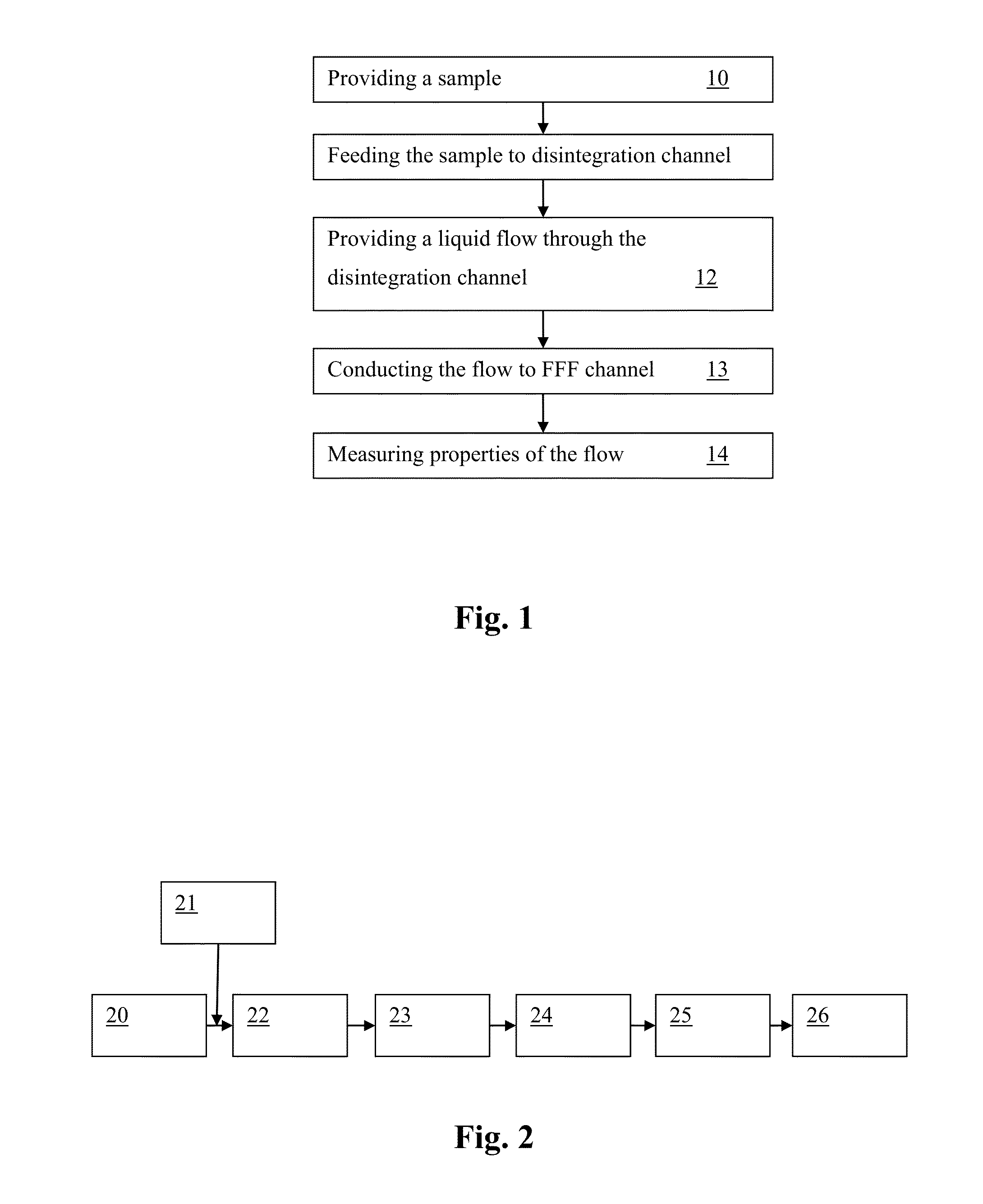Method and system for analyzing solid matter containing liquids and monitoring or controlling processes containing such liquids
a solid matter and monitoring technology, applied in the direction of suspension properties, instruments, measurement devices, etc., can solve the problems of inability to measure suspension properties using present on-line techniques, inability to obtain data as accurate as can be achieved in the laboratory, and related runnability problems
- Summary
- Abstract
- Description
- Claims
- Application Information
AI Technical Summary
Benefits of technology
Problems solved by technology
Method used
Image
Examples
example 1
[0087]The effect of the disintegration tube is essential for a successful separation. FIG. 4 shows two runs in the same field flow fractionator cell with (lower graph) and without (upper graph) a disintegration tube. The sample contained mainly TMP fines. Without the disintegration the fines flocculated in the cell and therefore, particles of same mass did not exit the cell at the same time (upper graph). However, when the disintegration was used, all the fines exited the cell as a uniform population (lower graph). It is clear that without disintegration the required level of separation is not achieved due to heavy flocculation.
[0088]The measurement device comprised an on-line turbidity sensor.
example 2
[0089]FIG. 5 illustrates analysis results of a wire water sample from a fine paper machine analyzed according to the invention. Such samples contain both small and large particles.
[0090]The large particles in this case are pigment aggregates and the small particles mainly dispersed pigment and wood fines. It can be seen that the respective peaks are clearly shown in a turbidity measurement following the present fractionation process. Large particles elute through the system much later than the small particles.
[0091]The results were compared to and the fractionation efficiency was evaluated by flow cytometry. Comparison indicated similar particle distributions and therefore proved that the present fractionator system is capable of separating the two main particle size populations very reliably and accurately.
[0092]In FIG. 6 the same sample as shown in FIG. 5 is presented as particle size distributions of the different 50 mL fractionator samples. During the fractionation run the sampl...
example 3
[0093]FIGS. 8a-8d shows an example of a sample run through the system including online turbidity sensor and image analyzer. The sample was a wire water sample. Turbidity trend shows that the system separates the particles of the sample into two populations (FIG. 8a). Image analysis results show (FIGS. 8b and 8c) that the lightest / smallest particles are coming first from the disintegration and FFF channels. The mean diameter of detected particles is ˜25 μm in the first population. The mean diameter of particles in the second population is 50 μm. The shape factors (roundness and coarseness) of particles change as a function of time (see FIG. 8d) indicating that the type of the particles in these two populations is different. Mean roundness value of particles is higher in the first population meaning that they are more spherical Coarseness value of particles is higher for the second population.
[0094]This example shows using a plurality of different measurement techniques and parameters...
PUM
| Property | Measurement | Unit |
|---|---|---|
| cross-sectional area | aaaaa | aaaaa |
| cross-sectional area | aaaaa | aaaaa |
| flow rate | aaaaa | aaaaa |
Abstract
Description
Claims
Application Information
 Login to View More
Login to View More - R&D
- Intellectual Property
- Life Sciences
- Materials
- Tech Scout
- Unparalleled Data Quality
- Higher Quality Content
- 60% Fewer Hallucinations
Browse by: Latest US Patents, China's latest patents, Technical Efficacy Thesaurus, Application Domain, Technology Topic, Popular Technical Reports.
© 2025 PatSnap. All rights reserved.Legal|Privacy policy|Modern Slavery Act Transparency Statement|Sitemap|About US| Contact US: help@patsnap.com



